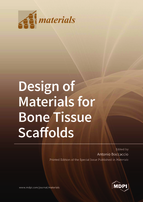Design of Materials for Bone Tissue Scaffolds
A special issue of Materials (ISSN 1996-1944). This special issue belongs to the section "Biomaterials".
Deadline for manuscript submissions: closed (31 May 2021) | Viewed by 37538
Special Issue Editor
Interests: bioengineering; morphological optimization of biomaterials; modeling and simulation of biomedical devices and mechanobiological processes; optical techniques for reverse engineering; characterization of biomedical materials
Special Issues, Collections and Topics in MDPI journals
Special Issue Information
Dear Colleagues,
The recent development of additive manufacturing techniques has allowed the building of regular scaffolds made from a very wide gamma of biocompatible materials and including complex and sophisticated geometries that can be optimized to increase the scaffold performance in terms of mechanical resistance and mechanobiological properties. This has made the design process of materials for bone tissue scaffolds an issue of crucial importance and the object of study of many researchers throughout the world. It is commonly known, in fact, that the rate of bone tissue regeneration and the cellular response is significantly influenced by the scaffold structural response that is, in turn, a function of the scaffold micro-architecture and of the mechanical properties of the material it is made from. The adhesion of stem cells to the scaffold surface as well as the tissue differentiation process occurring in the scaffold pores, are regulated by mechanobiological mechanisms taking place at both the micro- (i.e. some micrometers, approximately the dimension of a stem cell) and macro- (i.e. some hundreds of micrometers, the dimension of scaffold pores) level, respectively. The scaffold surface must be adequately structured to favor the adhesion of stem cells and their consequent differentiation. Similarly, the scaffold architecture must be properly shaped and the scaffold material must be adequately designed to trigger favorable biophysical stimuli, leading to the formation of the bony tissue.
Different studies have recently been published with the aim of better understanding the relationship between the scaffold geometry/material properties and the consequent mechanobiological phenomena taking place inside the scaffold during the regeneration process. However, no clear explanations are yet available on the relationship existing between the mechanical environment and the consequent biological response of tissues occupying the scaffold pores. This Special Issue will gather papers by materials scientists and bone tissue engineers focusing on (but not limited to):
- design techniques to optimize the scaffold performance;
- design of microstructured surfaces to favor the adhesion of stem cells;
- in vitro/in vivo studies aimed to establish relationships between the scaffold structural response and the tissue regeneration process;
- development of innovative biomaterials to fabricate scaffolds for bone tissue engineering;
- optimization of additively manufactured materials to increase scaffold performance;
- computational mechanobiological models simulating the tissue differentiation process in scaffolds.
Dr. Antonio Boccaccio
Guest Editor
Manuscript Submission Information
Manuscripts should be submitted online at www.mdpi.com by registering and logging in to this website. Once you are registered, click here to go to the submission form. Manuscripts can be submitted until the deadline. All submissions that pass pre-check are peer-reviewed. Accepted papers will be published continuously in the journal (as soon as accepted) and will be listed together on the special issue website. Research articles, review articles as well as short communications are invited. For planned papers, a title and short abstract (about 100 words) can be sent to the Editorial Office for announcement on this website.
Submitted manuscripts should not have been published previously, nor be under consideration for publication elsewhere (except conference proceedings papers). All manuscripts are thoroughly refereed through a single-blind peer-review process. A guide for authors and other relevant information for submission of manuscripts is available on the Instructions for Authors page. Materials is an international peer-reviewed open access semimonthly journal published by MDPI.
Please visit the Instructions for Authors page before submitting a manuscript. The Article Processing Charge (APC) for publication in this open access journal is 2600 CHF (Swiss Francs). Submitted papers should be well formatted and use good English. Authors may use MDPI's English editing service prior to publication or during author revisions.
Keywords
- Geometry optimization of scaffolds
- Micro-structured surfaces
- Cell adhesion
- Computational mechanobiology
- Additively manufactured materials







